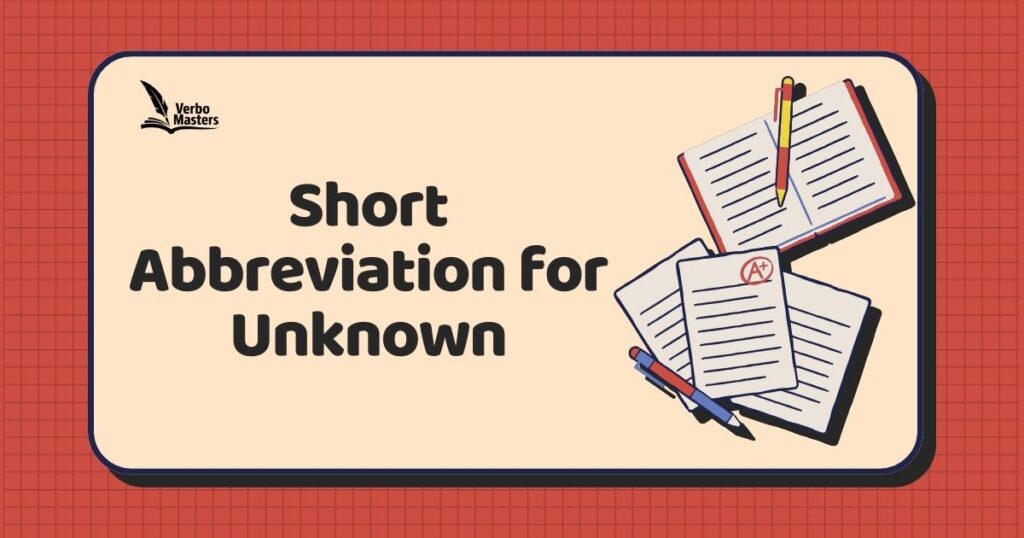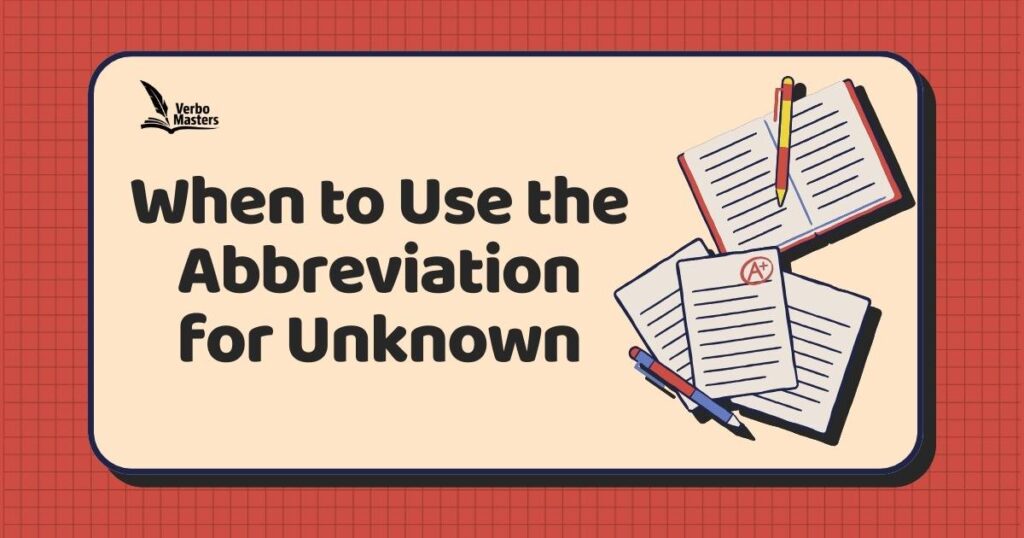The abbreviation for “unknown” is often “UNK.” It’s commonly used to represent something that is not identified or is yet to be discovered. You might see it in various contexts like forms, reports, or even online discussions.
“UNK” helps save space and time when dealing with information that isn’t available or clear. It’s especially useful in technical, scientific, and data-related fields. Understanding this abbreviation can make interpreting data or documents easier when dealing with unspecified or missing information.
What is the Abbreviation for Unknown?
The abbreviation “UNK” is a common shorthand used to represent the word “unknown.” This abbreviation helps save space and time in writing, particularly in situations where something is uncertain, missing, or unidentified. Whether in scientific research, data entry, or casual conversations, “UNK” makes it easier to quickly convey that the information is not available. Let’s explore how “UNK” is used across different contexts and why it’s such a useful abbreviation.
- Used in forms – “UNK” often appears when a detail is missing or unknown on a form.
- Data entry – In databases, “UNK” can indicate that certain data is not available or not provided.
- Scientific research – Researchers use “UNK” when results or conditions are not yet determined.
- Medical records – Doctors and nurses may use “UNK” for unknown conditions or test results.
- Legal documents – When a detail is unclear or unspecified in legal matters, “UNK” may be used.
- In surveys – Respondents might select “UNK” if they’re unsure or don’t know the answer.
- Weather reports – “UNK” can be used for weather conditions that haven’t been identified yet.
- Statistical analysis – It helps to note unknown values or missing data in reports and studies.
- Census records – When a response is missing or not applicable, “UNK” often replaces the blank.
- Library cataloging – When information about a book or author is unknown, “UNK” is used.
- Inventory tracking – Items without specific identification or details are marked as “UNK.”
- Customer service – If a problem is unresolved or details are missing, customer service may note “UNK.”
- Social media posts – Users may tag posts with “UNK” when they are unsure about something they’re sharing.
- Geographical data – Locations or places that are not yet identified can be marked as “UNK.”
- Historical research – Unknown historical facts or unclear events can be referenced as “UNK.”
- Programming – In coding, “UNK” can denote missing or undefined values in a variable.
- Product information – Unknown product details or specifications may be listed as “UNK.”
- Sports statistics – For athletes, “UNK” may represent unreported or unverified statistics.
- Company reports – Missing financial data or incomplete reports might use “UNK” for unknown values.
- Shipping information – If a package’s current status is unknown, it may be marked as “UNK.”
- Inventory discrepancies – Stock that can’t be identified may be labeled as “UNK.”
- Customer feedback – In reviews or ratings, “UNK” can indicate an unknown response or rating.
- Phone numbers – When an area code or number is unavailable, “UNK” may replace it.
- Machine error logs – When a system error can’t be identified, “UNK” helps label the issue.
- Event planning – Unknown dates or details about an event may be marked as “UNK.”
Abbreviations like “UNK” streamline communication when information is unavailable or uncertain. It’s a helpful tool across a variety of fields, keeping things efficient and clear.
What Does Abbreviation for Unknown Mean?
“UNK” is a simple abbreviation used to signify that something is unknown, undefined, or not available. Whether you’re working on a form, research paper, or online survey, this abbreviation makes it clear that the information is missing or uncertain. It is especially useful in fields like science, medicine, and data collection, where not all details are immediately accessible or confirmed. Here’s a deeper look at how “UNK” is applied in different contexts.
- Represents missing information – “UNK” is a quick way to show that something is not known.
- Common in databases – It’s used to mark missing or incomplete data entries.
- Essential in research – Researchers often use “UNK” when a result or variable is not yet clear.
- Widely used in forms – When filling out forms, “UNK” replaces unknown fields or options.
- In medical contexts – Used in patient records when a diagnosis or detail is unknown.
- Clarifies data gaps – In data science, “UNK” makes gaps in datasets clear.
- Streamlines communication – Using “UNK” makes it easy to acknowledge something unknown without elaboration.
- Saves time – Rather than explaining an unknown, you can just mark it as “UNK.”
- Helpful in inventory management – If the origin of an item is unclear, it’s listed as “UNK.”
- Useful in legal cases – Lawyers use “UNK” when certain facts are yet to be determined.
- Indicates uncertainty – “UNK” tells people that the information is not available or decided.
- Used in statistical reports – When reporting on data, “UNK” marks variables that are not known.
- In emergency situations – For unknown conditions or victims, “UNK” is used.
- In environmental science – When certain ecological data is unavailable, “UNK” is noted.
- In customer service logs – “UNK” might appear when details about an issue are missing.
- In surveys and polls – If a respondent skips a question, it might be marked as “UNK.”
- Common in scientific experiments – When results are inconclusive, “UNK” may represent the uncertainty.
- Used in technology – In software or hardware diagnostics, “UNK” can denote undefined errors.
- In product reviews – If a reviewer doesn’t know or didn’t specify something, “UNK” is used.
- On maps and charts – When locations are unidentified or uncertain, “UNK” might be used.
- On shipping labels – For packages with missing details, “UNK” replaces the unknown info.
- For demographic data – Missing or unknown demographic information is labeled as “UNK.”
- During research studies – “UNK” helps track unknowns in ongoing research.
- For stock market data – When specific figures are unavailable, “UNK” may be used.
- In programming error handling – Missing or incorrect code data often results in “UNK.”
The abbreviation “UNK” provides a universal shorthand for uncertainty, making communication more efficient in many fields. It clearly signifies a lack of knowledge or unavailable data, helping others quickly grasp that the information is missing.
You can also read; Abbreviation for Thanks? Definition & Meaning
Definition, Pronunciation, and Examples
The abbreviation “UNK” stands for “unknown” and is widely used in different fields to indicate missing or undefined information. It’s pronounced exactly as it looks, with the letters “U-N-K” spoken individually. In daily usage, “UNK” is an easy way to fill in for something that cannot be identified or is still unknown. Whether it’s used in research, medical records, or even casual conversations, it helps quickly express uncertainty or an absence of data. Let’s explore how this abbreviation is applied in real-life situations.
- In scientific reports – “The exact cause of the issue remains UNK.”
- In census data – “Gender is listed as UNK for some individuals.”
- In surveys – “Respondent’s age: UNK.”
- On forms – “Date of birth: UNK.”
- In medical charts – “Allergy status: UNK.”
- During weather forecasting – “The exact location of the storm is still UNK.”
- In sports stats – “The player’s performance stats are UNK for this season.”
- In customer service – “Issue resolution status: UNK.”
- In academic papers – “The experiment’s outcome was UNK at the time of publication.”
- In business reports – “Quarterly sales are UNK due to missing data.”
- In legal filings – “Identity of the suspect remains UNK.”
- On inventory lists – “Item origin: UNK.”
- In tech error logs – “Cause of the system failure: UNK.”
- In online databases – “Product details: UNK.”
- In shipping logs – “Delivery status: UNK.”
- In financial reports – “Transaction status: UNK.”
- In historical records – “Exact date of the event: UNK.”
- On online forms – “Email address: UNK.”
- During interviews – “Candidate’s previous experience: UNK.”
- On official documents – “Witness account: UNK.”
- In research findings – “Results of test X are UNK.”
- In government statistics – “Voter turnout in some districts: UNK.”
- In entertainment – “Director’s next film project: UNK.”
- In personal communications – “Meeting location: UNK.”
- In market analysis – “Market trends for next quarter: UNK.”
The Pronunciation of “Unknown”
Pronouncing the word “unknown” is straightforward, but when abbreviated as “UNK,” it’s simply said as “U-N-K.” It’s an easy-to-understand pronunciation, with each letter being articulated separately. The same goes for its use in conversation or text: people recognize “UNK” immediately as referring to something unidentified or uncertain. Understanding how to pronounce it can be useful when you come across this abbreviation in various contexts. Here’s a closer look at how “UNK” fits into everyday language.
- Text messaging – “What time is the event? UNK.”
- Medical reports – “Allergy status: UNK.”
- Survey responses – “Do you know the answer? UNK.”
- Legal records – “Witness statement: UNK.”
- Census data – “Address: UNK.”
- Research findings – “Outcome of the test: UNK.”
- In conversations – “Who was involved? UNK.”
- Business meetings – “Sales for this quarter: UNK.”
- In reports – “Product shipment status: UNK.”
- On inventories – “Item’s condition: UNK.”
- During customer service interactions – “Issue resolution: UNK.”
- Online forms – “Phone number: UNK.”
- In historical contexts – “Exact date: UNK.”
- In weather discussions – “The storm’s path: UNK.”
- In financial conversations – “Transaction details: UNK.”
- For unverified data – “Market trends: UNK.”
- In tech troubleshooting – “Error code: UNK.”
- On shipping receipts – “Package delivery: UNK.”
- For unknown locations – “Meeting spot: UNK.”
- During interviews – “Candidate’s past job: UNK.”
- In educational settings – “Test score: UNK.”
- In product catalogs – “Price: UNK.”
- On forms for missing info – “Email: UNK.”
- In personal notes – “Friend’s contact: UNK.”
- On maps or GPS – “Location: UNK.”
Short Abbreviation for Unknown

The abbreviation “UNK” is the most commonly used shorthand for “unknown.” It’s a simple and quick way to denote missing or undefined information in a variety of settings. Whether it’s used in forms, surveys, or data reports, “UNK” allows people to acknowledge the absence of knowledge without needing to write the full word. Its simplicity makes it a favorite in fields where efficiency and clarity are important. Let’s look at some of the many instances where “UNK” is used to keep things concise.
- In forms – “Age: UNK.”
- In research studies – “Outcome: UNK.”
- In medical charts – “Diagnosis: UNK.”
- In survey answers – “Response: UNK.”
- On inventory lists – “Item condition: UNK.”
- In business reports – “Sales data: UNK.”
- For customer feedback – “Product satisfaction: UNK.”
- In historical records – “Event date: UNK.”
- On shipping forms – “Delivery status: UNK.”
- In weather reports – “Storm location: UNK.”
- During technical troubleshooting – “Error cause: UNK.”
- In social media posts – “Info: UNK.”
- In official documents – “Witness statement: UNK.”
- In data entries – “Price: UNK.”
- On tax forms – “Income: UNK.”
- In legal documents – “Defendant’s location: UNK.”
- In educational assessments – “Test score: UNK.”
- In market analysis – “Trend data: UNK.”
- In event planning – “Location: UNK.”
- For unconfirmed research results – “Finding: UNK.”
- In personal records – “Contact info: UNK.”
- For unknown variables in equations – “X value: UNK.”
- In sports stats – “Player performance: UNK.”
- In customer service logs – “Issue resolution: UNK.”
- In product specifications – “Dimensions: UNK.”
By using “UNK” instead of writing out the word “unknown,” various industries and individuals can keep their communication efficient and to the point, helping to maintain clarity even when the information is unavailable.
Acronym for Unknown?
An acronym for “unknown” is “UNK,” which is often used to replace the full word. While the term “acronym” typically refers to a set of initials that form a word (like NASA for National Aeronautics and Space Administration), “UNK” is a shortened form, which can also be referred to as an abbreviation. “UNK” is commonly used across many fields, such as data analysis, research, and everyday communication. It’s a way to acknowledge the lack of information quickly and without confusion.
- In databases – “Customer name: UNK.”
- In forms – “Missing data: UNK.”
- In research papers – “Conclusion: UNK.”
- In legal proceedings – “Defendant’s age: UNK.”
- On inventory sheets – “Quantity: UNK.”
- In weather forecasting – “Storm direction: UNK.”
- In medical reports – “Diagnosis: UNK.”
- In social media – “Event location: UNK.”
- In surveys – “Respondent’s answer: UNK.”
- In customer service records – “Issue resolution: UNK.”
- On shipping labels – “Tracking number: UNK.”
- In education assessments – “Grade: UNK.”
- In financial reports – “Profit: UNK.”
- For programming errors – “Code issue: UNK.”
- In tax documents – “Deduction: UNK.”
- In historical archives – “Event year: UNK.”
- In market research – “Product demand: UNK.”
- For technical problems – “Cause: UNK.”
- In project management – “Timeline: UNK.”
- In customer feedback – “Satisfaction level: UNK.”
- In scientific data – “Test result: UNK.”
- On official paperwork – “ID number: UNK.”
- In personal records – “Phone number: UNK.”
- In product inventory – “Brand: UNK.”
- On maps or charts – “Location: UNK.”
Although not a traditional acronym, “UNK” functions as a shorthand representation for unknown details, making it especially useful when there’s a need for brevity in reporting, documentation, or informal communication.
“UNK” vs. “N/A”: When to Use Each
The abbreviations “UNK” and “N/A” both represent missing or unavailable information, but they are used in different contexts. “UNK” stands for “unknown,” which implies that the information is not known or hasn’t been determined yet. On the other hand, “N/A” stands for “not applicable,” used when a question or item doesn’t apply to the situation. Understanding the difference can help ensure accurate communication when filling out forms, surveys, or reports. Here’s how to decide when to use each one.
- For missing information – Use “UNK” when the information is missing but could potentially be known later.
- For irrelevant data – Use “N/A” when the question or field doesn’t apply to the situation at all.
- In research – “UNK” is used for unknown results, while “N/A” is for irrelevant parameters.
- In surveys – “UNK” is used when the respondent doesn’t know the answer; “N/A” is used when the question is not relevant to them.
- In forms – “UNK” is used when a detail is unknown, while “N/A” is used when the question doesn’t apply.
- In medical records – “UNK” is used for conditions not yet diagnosed; “N/A” is used when a field is not relevant to the patient.
- In customer feedback – “UNK” can be used for missing information, while “N/A” is used when the feedback category is irrelevant.
- In legal documents – “UNK” applies when facts are not yet known, while “N/A” applies to questions that don’t apply to the case.
- In statistical analysis – “UNK” indicates missing data; “N/A” shows data that doesn’t apply to the context.
- In financial reports – “UNK” may be used for missing financial details, while “N/A” is used for fields that are not relevant to the financial analysis.
- In shipping details – “UNK” may be used for unknown delivery status, while “N/A” is used when a shipping field doesn’t apply.
- In inventory systems – “UNK” indicates missing information about an item; “N/A” indicates a field not applicable to that item.
- In educational records – “UNK” is used for unknown grades or scores, while “N/A” is used for questions or sections not relevant to the student.
- For unknown conditions – Use “UNK” for conditions that have not been diagnosed; use “N/A” for treatments that do not apply to the case.
- In technology troubleshooting – “UNK” is used for unknown errors; “N/A” is used when a diagnostic step doesn’t apply.
- In product specifications – “UNK” is used when a feature is unknown; “N/A” is used when the feature is not included.
- In personal forms – “UNK” is used for missing personal details; “N/A” is used when the field doesn’t apply to the individual.
- In surveys for demographics – “UNK” is used for missing demographic information; “N/A” is used for irrelevant demographic categories.
- In market research – “UNK” is used when data is missing; “N/A” is used when a product feature doesn’t apply to the market.
- In contract agreements – “UNK” is used for terms that are uncertain; “N/A” is used for clauses that do not apply.
- In user feedback – “UNK” is used when users leave information blank, while “N/A” is used when a feedback question is not relevant.
- In employment records – “UNK” is used when information such as employment dates is not known; “N/A” is used when a field is not relevant.
- For unknown responses – “UNK” is used for missing answers, while “N/A” is used when the response isn’t needed.
- In research findings – “UNK” is used when results are pending; “N/A” is used when findings don’t apply to the research.
- In budgeting reports – “UNK” is used when budget information is missing; “N/A” is used for irrelevant financial data.
knowing when to use “UNK” and when to use “N/A” can make a big difference in keeping your communication clear. Use “UNK” when information is missing or unknown, and “N/A” when something doesn’t apply to the situation.
Other Examples of Unknown in Context
The abbreviation “UNK” is used in a wide range of fields to represent something that is not known or undefined. From medical records to surveys, it’s a helpful tool for efficiently acknowledging missing data. There are various ways “UNK” appears in everyday communication, from personal forms to scientific reports. Here are some additional examples of how “UNK” is used across different contexts.
- In research papers – “The final conclusion is still UNK due to ongoing experiments.”
- In customer service logs – “Issue resolution is currently UNK.”
- On forms – “Phone number: UNK.”
- In inventory tracking – “Manufacturer details: UNK.”
- In weather forecasting – “Storm’s exact path: UNK.”
- In sports statistics – “Player’s injury status: UNK.”
- In product catalogs – “Color options: UNK.”
- In legal proceedings – “Defendant’s whereabouts: UNK.”
- In business reports – “Quarterly revenue: UNK.”
- In surveys – “Income level: UNK.”
- In academic grading – “Test results: UNK.”
- On shipping labels – “Package location: UNK.”
- In historical research – “Exact year of event: UNK.”
- In programming – “Variable value: UNK.”
- In tax filing – “Taxable amount: UNK.”
- In medical diagnosis – “Cause of symptoms: UNK.”
- In product specification sheets – “Weight: UNK.”
- In financial analysis – “Interest rate: UNK.”
- In software troubleshooting – “Error cause: UNK.”
- In customer reviews – “Product satisfaction: UNK.”
- On maps – “Landmark location: UNK.”
- In personal records – “Emergency contact: UNK.”
- On census data – “Respondent’s age: UNK.”
- In event planning – “Guest list: UNK.”
- In user registration forms – “Username availability: UNK.”
“UNK” can be applied in various contexts where information is missing or unavailable. It provides a concise way to communicate that something is yet to be determined or disclosed.
Synonyms and Antonyms for Unknown

When we talk about “unknown,” there are several synonyms and antonyms that can help convey the same or opposite meanings, depending on the context. Synonyms can offer alternative ways of expressing the idea that something is not yet known or is hidden, while antonyms are used to describe information that is fully known or clear. Understanding these can enrich your vocabulary and improve communication.
Synonyms for Unknown:
- Unclear – Something that is not clearly defined.
- Unidentified – Not recognized or named.
- Undefined – Not specified or described.
- Mysterious – Having qualities that are hard to understand or explain.
- Obscure – Not well known or not easily understood.
- Ambiguous – Having more than one possible meaning.
- Uncertain – Not sure or not definite.
- Indeterminate – Not precisely determined.
- Vague – Not clearly expressed or understood.
- Incomprehensible – Impossible to understand.
- Cryptic – Having a hidden meaning.
- Hidden – Kept out of sight.
- Unrevealed – Not yet disclosed or made known.
- Unfamiliar – Not known or recognized.
- Indefinite – Without clear limits or definition.
- Secret – Kept hidden from others.
- Undisclosed – Not made known.
- Enigmatic – Puzzling or mysterious.
- Uncertain – Lacking certainty or confidence.
- Unknown quantity – Something whose value or outcome is not yet determined.
- Unseen – Not visible or observable.
- Unexplored – Not studied or investigated.
- Unacknowledged – Not recognized or admitted.
- Nameless – Without a name or identity.
- Unrevealed – Not yet made public or known.
Antonyms for Unknown:
- Known – Familiar or recognized.
- Clear – Easy to understand or definite.
- Certain – Fully assured or confirmed.
- Obvious – Easily seen or understood.
- Familiar – Well known or recognized.
- Defined – Clearly stated or outlined.
- Identified – Recognized or named.
- Revealed – Made known or disclosed.
- Confirmed – Verified or validated.
- Apparent – Easily perceived or understood.
- Transparent – Open and clear, with no secrets.
- Exposed – Made visible or public.
- Recognized – Acknowledged or identified.
- Visible – Able to be seen.
- Certain – Definite, without doubt.
- Undisputed – Not questioned or doubted.
- Clear-cut – Very distinct and easy to understand.
- Proven – Shown to be true.
- Explicit – Clearly and fully expressed.
- Decisive – Having a clear outcome or resolution.
- Confirmed – Established as true or accurate.
- Straightforward – Simple and clear to understand.
- Evident – Clearly seen or understood.
- Manifest – Clear or obvious to the mind.
- Documented – Written down and verified.
Understanding both synonyms and antonyms for “unknown” can help you communicate more effectively. You can choose a synonym when you want to express the idea of something being unclear or undiscovered, and use an antonym when you need to indicate that something is understood or certain.
The History of the Word Abbreviation for Unknown
The term “unknown” has been around for centuries, but its abbreviation “UNK” became popular in the modern era, especially with the advent of technology and digital communication. As the need for more concise ways to convey information grew, abbreviations like “UNK” became more common in fields like research, business, and daily life. The history of the abbreviation reflects a shift toward simplifying language, helping people communicate more efficiently, especially in contexts where time and space are limited.
- Early use – “Unknown” has been in the English language for centuries, but abbreviations began to take off with the rise of the digital age.
- In paperwork – Early documents used full words, but as forms grew more complex, abbreviations like “UNK” were introduced for simplicity.
- In the military – During wartime, abbreviations became crucial for quick communication. “UNK” was used in reports for missing or unidentified details.
- In business – As business communication became more streamlined, “UNK” was adopted to handle missing data efficiently.
- In technology – With the digital age, where brevity was key in character-limited fields (like coding and text messaging), “UNK” emerged as a standard.
- In medical records – Medical professionals used “UNK” to indicate unknown diagnoses or patient information in a concise manner.
- In scientific research – Researchers began using abbreviations for unknown data points to simplify complex reports.
- In forms and surveys – As the need for faster data entry grew, abbreviations like “UNK” became common on forms.
- With the rise of the internet – As online communication grew, abbreviations like “UNK” helped save time in casual chats and emails.
- In official documents – Legal and governmental documents adopted the use of “UNK” for missing information to reduce errors.
- In education – “UNK” began to appear in grading systems to represent missing student data.
- In statistical analysis – Analysts used “UNK” to represent unconfirmed or missing data points.
- In finance – Financial reports began to use “UNK” to reflect unavailable or unreported figures.
- In customer service – Customer service logs started adopting “UNK” when client details were missing or unknown.
- In social media – The abbreviation “UNK” quickly gained traction as part of the shorthand used in social media posts.
- In product descriptions – When certain product information was unavailable, “UNK” became a common abbreviation in catalogs.
- In inventory systems – Inventory systems adopted “UNK” to denote unknown quantities or items.
- In postal services – “UNK” was used when the destination or delivery status of a package was unclear.
- In weather forecasting – Meteorologists used “UNK” for locations or data points that were not yet confirmed or available.
- In legal cases – In legal documents, “UNK” was used to indicate an unknown party or detail in proceedings.
- In historical records – Historians used “UNK” when the exact details of a person or event could not be traced.
- In journalism – “UNK” was used in news reports for information that was not verified or was still under investigation.
- In sports statistics – “UNK” became a common notation for player stats that were unavailable or not reported.
- In project management – Project managers used “UNK” to represent unknown timelines or budgets.
- In everyday language – Over time, “UNK” became a common abbreviation in daily language, often used in informal settings.
the abbreviation “UNK” evolved alongside the growth of technology, efficiency, and the increasing need for concise communication. Its widespread use today shows how language adapts to changing communication needs.
When to Use the Abbreviation for Unknown

Knowing when to use the abbreviation “UNK” for “unknown” is important for clarity and precision in communication. The term is typically used in formal or informal contexts where information is missing, uncertain, or has yet to be determined. Whether you’re completing forms, filling out surveys, or discussing research data, using “UNK” can help indicate missing or unavailable information without taking up unnecessary space. Here are some guidelines on when to use “UNK” appropriately.
- In surveys – Use “UNK” when a participant doesn’t know the answer to a question.
- On forms – If you don’t know a specific detail, like a phone number or address, use “UNK.”
- In research – When data is missing or unavailable, you can mark it as “UNK.”
- In medical records – Use “UNK” for unknown symptoms, conditions, or patient information.
- In customer service – When information about a client is missing, “UNK” is often used in service logs.
- In inventory systems – If the quantity or status of an item is unclear, use “UNK” to mark it.
- In legal cases – If the identity or details of a person or entity are not confirmed, use “UNK.”
- On legal forms – Use “UNK” when a detail, such as a witness or time, is not known at the moment.
- In weather forecasting – When specific weather data, such as temperature or location, is unavailable, “UNK” is used.
- In statistics – Use “UNK” for missing data in statistical reports.
- In shipping details – If the exact delivery status is not known, mark it as “UNK.”
- In financial reports – When financial information is missing or still under review, use “UNK.”
- In educational records – If a grade or result is not yet determined, use “UNK.”
- In surveys for demographics – When demographic details like income or age are unknown, “UNK” can be applied.
- In social media – Sometimes “UNK” is used when users are unsure about sharing personal details.
- In technical reports – If certain data points or metrics are unknown, “UNK” can be used.
- In historical research – Use “UNK” when specific historical facts or dates are not yet uncovered.
- In event planning – When certain event details, such as guest list or timing, are uncertain, use “UNK.”
- In research papers – If a hypothesis or result is yet to be confirmed, you can mark it as “UNK.”
- In project management – When a project’s timeline or budget is uncertain, use “UNK.”
- In legal documents – If a piece of information is missing, such as a contract term or party involved, use “UNK.”
- In medical diagnoses – If a condition or disease is not yet identified, it’s often marked as “UNK.”
- In product descriptions – When information about a product is not provided, “UNK” can be used.
- In customer feedback – Use “UNK” when customers are unsure about giving certain information.
- In employee records – If specific employee details, such as work hours, are unknown, “UNK” is used.
“UNK” serves as a shorthand way of indicating missing or unavailable information. Using it properly can help maintain clarity in documents and communication, especially when dealing with incomplete or uncertain data.
Examples of the Word and Abbreviations in Context
The abbreviation “UNK” is widely used in various fields, especially in situations where information is unavailable or yet to be determined. Understanding how and where to use it is essential for clear communication. Below are several real-world examples of how “UNK” can be applied in different contexts, showcasing its versatility in everyday language.
- Research studies – “The patient’s recovery time is still UNK.”
- Customer service logs – “Customer’s complaint details: UNK.”
- Legal documentation – “Accused’s identity: UNK.”
- Medical reports – “Cause of symptoms: UNK.”
- Inventory tracking – “Item quantity: UNK.”
- Financial spreadsheets – “Estimated revenue: UNK.”
- Shipping details – “Delivery status: UNK.”
- Survey responses – “Respondent’s age: UNK.”
- Job applications – “Applicant’s previous experience: UNK.”
- Technical support tickets – “Issue resolution: UNK.”
- Social media profiles – “Location: UNK.”
- School grading systems – “Grade for exam: UNK.”
- Event planning – “Confirmed attendees: UNK.”
- Product listings – “Dimensions: UNK.”
- Tax records – “Income status: UNK.”
- Weather forecasts – “Storm’s exact location: UNK.”
- Sports statistics – “Player’s performance data: UNK.”
- Product specifications – “Weight of product: UNK.”
- Health records – “Patient’s condition: UNK.”
- Customer feedback surveys – “Satisfaction level: UNK.”
- Employee databases – “Employee’s contact details: UNK.”
- Survey results – “Survey participant’s income level: UNK.”
- Medical diagnoses – “Disease identification: UNK.”
- Online forms – “Email address: UNK.”
- Business reports – “Company’s market share: UNK.”
the abbreviation “UNK” is useful in a variety of scenarios where information is missing or unavailable. By using it appropriately, you ensure that the message is clear without overwhelming the reader with unnecessary details.
FAQs
What does “UNK” stand for?
“UNK” is an abbreviation for “unknown,” commonly used in different contexts to indicate information that is missing or not yet determined.
When should I use “UNK”?
You can use “UNK” when referring to something that is uncertain, not identified, or missing. It’s often seen on forms, in research, and in technical documentation.
What does “UNK” mean in surveys?
In surveys, “UNK” represents an answer that is unknown or not provided. It’s used when a respondent doesn’t know or refuses to answer a particular question.
Can “UNK” be used in medical reports?
Yes, “UNK” is often used in medical records to indicate that a patient’s symptoms, diagnosis, or condition is unknown or hasn’t been confirmed yet.
How is “UNK” used in inventory systems?
In inventory systems, “UNK” is used to denote unknown quantities of a product or the status of an item that has not been identified or counted.
Is “UNK” used in legal documents?
Yes, in legal documents, “UNK” can be used to indicate unknown details about a person, event, or piece of evidence that has not been identified or clarified.
Is “UNK” used in customer service?
Yes, in customer service logs, “UNK” is used to mark information that is missing or unclear about a customer’s issue or request.
Can “UNK” be used in social media?
Yes, “UNK” is used in social media to indicate that certain personal information, such as location or details about a user, is not shared or is unavailable.
Is “UNK” the same as “N/A”?
No, “UNK” means information is unknown, while “N/A” means information is not applicable to the situation.
Where else can I find “UNK” used?
“UNK” is used in a wide range of fields including research, statistics, shipping, weather reports, and more whenever data or information is missing or not yet available.
Conclusion
The abbreviation “UNK” is widely used to represent the word “unknown.” It is often found in various fields such as research, customer service, and inventory management. This shorthand is helpful for denoting missing or unavailable information quickly and clearly.
The abbreviation also helps in reducing errors and maintaining consistency in reporting. Whether you’re working with surveys, inventories, or technical documents, “UNK” ensures that gaps in information are clearly identified.

I’m John Smith, a language enthusiast dedicated to helping writers, students, and professionals master the art of clear and effective communication. Whether you’re looking for grammar tips, writing guides, or common mistake corrections, you’ll find valuable insights to improve your language skills. Let’s make grammar simple and fun!

